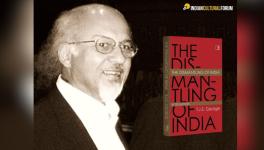Is Dynastic Succession Really an Issue in Indian Politics?

Representational image. | Image Courtesy: Deccan Chronicle
Last week we saw a number of commentaries and op-eds on why the Gandhis are a stumbling block to the reinvention of the Congress party. Their thrust was that if we do away with the Gandhi dynasty then we are all set for a rejuvenated Congress that will take on the Modi juggernaut. It is a fact that the Congress needs to reinvent itself, but dynastic politics is not a central issue in popular politics.
Prime Minister Narendra Modi has succeeded in making dynastic succession into a narrative that then got hooked onto an anti-elitist populist discourse, yet there is little merit in thinking that this is the key issue that is holding back a revamp of the Congress. This, in fact, is a red herring that Modi wishes to throw up at us so that no alternative to his party’s narrative actually emerges.
Dynastic politics is being seen by the newly-emerging second generation of urban elites and middle classes as a form of entitlement. That is how the aspirational lower class, that is mostly self-made, also see political dynasties. Modi managed to create an optics, by self-representing himself, that fits this narrative. However, beyond the pale of these classes there is also a possibility of reading dynasty as a symbol or face in a faceless political horizon.
Not just the Congress, almost all other political parties from the Dravida Munnetra Kazhagam (DMK) in Tamil Nadu to the Bharatiya Janata Party (BJP) and Janata Dal (Secular) or JD(S) in Karnataka, the Telugu Desam Party in Andhra Pradesh, Telangana Rashtra Samithi in Telangana, the All India Trinamool Congress in West Bengal, the Bahujan Samaj Party and Samajwadi Party in Uttar Pradesh, Rashtriya Janata Dal in Bihar, and all other regional parties, including the BJP in states, have a younger generation of leaders whose parents have been or still are active in politics.
Most of the regional parties that won elections recently, the JD(S) came to power in Karnataka under HD Kumarswamy, whose father was HD Deve Gowda, the former prime minister and state chief minister. The DMK is pitching for power under MK Stalin, the son of Karunanidhi, the former state chief minister. Similarly, Nara Lokesh, son of former chief minister N Chandrababu Naidu, has taken over the reins of the TDP in Andhra Pradesh, and there is already a shift of power in the TRS to KT Rama Rao, whose father, K Chandrashekar Rao, is the first Chief Minister of Telangana.
How then does dynasty become a central issue in Indian politics? Why is it being made so central in the critique against the Congress? Even if the criticism is valid, is it really a fundamental factor that is holding back the Congress?
In post-colonial democracies, with large sections of illiterate and poorly-literate population groups, symbols remain an important element in political participation. During the anti-colonial movement, Gandhi led through the use of popular symbols; the Charkha and Khadi referred to self-reliance, salt became a symbol of self-respect, Ashram of asceticism and honesty, and so on. Symbols help mainstream the marginalised social groups and aid their participation in mass politics. Symbols help people grasp the nuances of political values and narratives.
In post-independence India, the founding members opted for universal adult franchise when India had a just about 40% rate of literacy. The right to vote was considered a revolutionary and sometimes dangerous decision, but it worked because political parties, following up on the anti-colonial movement, inaugurated fresh symbols to galvanise mass participation. Family and dynasty also emerged as symbols in this era, and were in fact further entrenched when neo-liberal reforms brought in a facelessness to the economic and social process in a country whose population groups were essentially local and territorially-bound.
Economic changes were being made through global capital flows, through financial capital free-flowing across national and state borders, and multinational corporations that are faceless. The economic insecurities of neo-liberal globalisation and the facelessness of the new policy-making processes made it necessary to have concrete political symbols that could be reference points and which could be held responsible for the concrete impact that these policies had on people’s lives. This is where dynasties became not redundant but more significant. They reflect not just old-age entitlement but accountability.
With most regional parties reduced to transactional politics, and very little marking them as different in terms of their economic policies, it is individual leaders who came to promise welfare to people, while their parties pursued a growth-centric corporate model of development. There emerged a surreal conflict between party, policy and leader within the same political outfit. During the previous United Progressive Alliance regime, while Manmohan-Montek (with Chidambaram and Sibal) reflected the faceless dynamic that propelled neo-liberal policies, it was essentially Sonia Gandhi and the National Advisory Council or NAC that stood as a symbol of welfarism.
Therefore, dynastic rule in the Indian context has roughly translated into symbols of populist sops and welfarism as against fast-paced neoliberalism that was delegitimising welfare policies such as subsidies, the Public Distribution System, employment guarantee, among others.
Today we are in the midst of a Modi juggernaut that has centralised power between two individuals. In fact, from one family we have literally moved to one individual (or two). How is a critique against dynasty valid from a leader and a party that has not decentralised but further concentrated power in one individual, even if we can read it as two individuals? A put-down of entitlement is being transformed into a centralised leadership model that is more autocratic than any family rule could so far enjoy in India. Even under Indira Gandhi there were alternative power centres in the Congress, including regional leaders, unlike what we are witnessing today.
Politics always has layered narratives that mean many different things. While a critique of dynasty is necessary for the expansion of democratic content, in the current context that is not what is happening. Instead, one can clearly see that the Gandhi family has been at the forefront, with Congress leader Rahul Gandhi alone offering a stringent criticism of Modi and his policies, while the rest are playing ball. In such a context, making dynasty politics more significant than it actually is is not only misplaced but can be severely counter-productive in curbing the authoritarian turn Indian politics has taken.
We need to bring thicker ideological issues related to the model of growth, centralisation of power, exclusion and violence against Dalits and religious minorities, intimidation and undermining of institutions, including the judiciary and media into the discussion. Dynasty would then not figure prominently in the political discourse, except within the ranks of the BJP and its leadership.
The author is associate professor, Centre for Political Studies, JNU. He recently published an edited volume, Secular Sectarianism: Limits of Subaltern Politics (Sage, 2019). The views are personal.
Get the latest reports & analysis with people's perspective on Protests, movements & deep analytical videos, discussions of the current affairs in your Telegram app. Subscribe to NewsClick's Telegram channel & get Real-Time updates on stories, as they get published on our website.
























